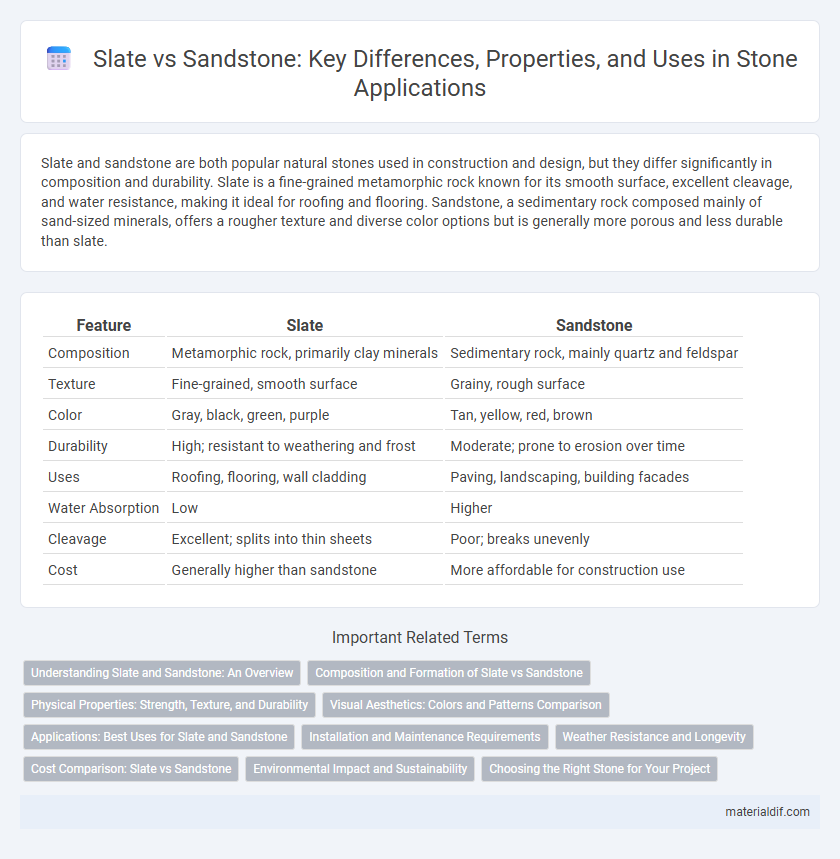Slate and sandstone are both popular natural stones used in construction and design, but they differ significantly in composition and durability. Slate is a fine-grained metamorphic rock known for its smooth surface, excellent cleavage, and water resistance, making it ideal for roofing and flooring. Sandstone, a sedimentary rock composed mainly of sand-sized minerals, offers a rougher texture and diverse color options but is generally more porous and less durable than slate.
Table of Comparison
| Feature | Slate | Sandstone |
|---|---|---|
| Composition | Metamorphic rock, primarily clay minerals | Sedimentary rock, mainly quartz and feldspar |
| Texture | Fine-grained, smooth surface | Grainy, rough surface |
| Color | Gray, black, green, purple | Tan, yellow, red, brown |
| Durability | High; resistant to weathering and frost | Moderate; prone to erosion over time |
| Uses | Roofing, flooring, wall cladding | Paving, landscaping, building facades |
| Water Absorption | Low | Higher |
| Cleavage | Excellent; splits into thin sheets | Poor; breaks unevenly |
| Cost | Generally higher than sandstone | More affordable for construction use |
Understanding Slate and Sandstone: An Overview
Slate is a fine-grained metamorphic rock derived from shale with a smooth, foliated texture ideal for roofing and flooring. Sandstone is a sedimentary rock composed mainly of sand-sized mineral particles, featuring a coarse texture and high durability, commonly used in construction and decorative elements. Both stones differ significantly in formation processes, mineral composition, and typical applications within architecture and design.
Composition and Formation of Slate vs Sandstone
Slate is a fine-grained metamorphic rock formed through the low-grade metamorphism of shale, primarily composed of clay minerals and quartz, resulting in a foliated texture that allows it to split into thin, durable sheets. Sandstone is a sedimentary rock composed mainly of sand-sized mineral particles, often quartz and feldspar, cemented by silica, calcium carbonate, or iron oxides, formed through the compaction and lithification of sand deposits. The metamorphic process of slate alters its original sedimentary composition, giving it greater density and hardness compared to the loosely cemented, porous nature of sandstone.
Physical Properties: Strength, Texture, and Durability
Slate offers higher strength and exceptional durability due to its fine-grained, foliated texture formed by metamorphic processes, making it resistant to pressure and weathering. Sandstone, with its coarse-grained, sedimentary composition, exhibits moderate strength and porosity, resulting in lesser durability but easier workability. The dense, cleavage structure of slate outperforms sandstone in load-bearing applications and long-term structural use.
Visual Aesthetics: Colors and Patterns Comparison
Slate exhibits a rich palette of deep grays, blues, greens, and purples with a smooth, fine-grained texture that often shows subtle layering and natural clefts, creating a dramatic, elegant visual effect. Sandstone offers warmer tones including beige, tan, red, and brown, featuring a coarser, granular texture with organic, swirled, or banded patterns that evoke a rustic, earthy ambiance. The choice between slate and sandstone significantly impacts design aesthetics, with slate emphasizing sleek sophistication and sandstone providing naturally textured warmth.
Applications: Best Uses for Slate and Sandstone
Slate excels in roofing, flooring, and wall cladding due to its durability, low water absorption, and excellent cleavage properties that allow it to be split into thin, uniform sheets. Sandstone is ideal for outdoor paving, garden walls, and decorative facades because of its natural texture, porosity, and weather resistance in diverse climates. Both stones are commonly used in landscaping, but slate is preferred for indoor applications requiring fine, smooth finishes while sandstone suits rustic, natural designs.
Installation and Maintenance Requirements
Slate installation demands a skilled approach due to its natural cleavage, requiring precise cutting and specialized tools to prevent cracking. Sandstone is more forgiving in installation but often needs a stable substrate to avoid shifting or erosion over time. Maintenance for slate involves regular sealing to preserve its water resistance, while sandstone requires frequent cleaning and sealing to prevent staining and weather damage.
Weather Resistance and Longevity
Slate exhibits superior weather resistance compared to sandstone due to its dense, fine-grained structure and low porosity, making it highly durable against moisture, freeze-thaw cycles, and chemical erosion. Sandstone, while aesthetically appealing with its granular texture, is more porous and susceptible to weathering processes, leading to faster surface degradation and reduced longevity in harsh environments. For long-term applications in exterior settings, slate is preferred for its exceptional resistance to weathering and extended lifespan.
Cost Comparison: Slate vs Sandstone
Slate generally comes at a higher price point than sandstone due to its durability and refined appearance, with costs typically ranging from $10 to $30 per square foot compared to sandstone's $5 to $15 per square foot. Installation expenses for slate can also be higher because of its denser, heavier nature which requires specialized tools and labor. Sandstone offers a more budget-friendly option, especially for large-scale projects or landscaping, balancing aesthetic appeal with cost efficiency.
Environmental Impact and Sustainability
Slate exhibits superior durability and a lower environmental footprint due to its natural cleavage, which allows for efficient extraction with minimal waste, whereas sandstone requires more intensive quarrying that often leads to greater habitat disruption. The long lifespan and low maintenance needs of slate reduce replacement frequency, contributing to improved sustainability in sustainable construction projects. Sandstone's higher porosity increases its vulnerability to weathering, potentially leading to more frequent repairs and environmental costs over time.
Choosing the Right Stone for Your Project
Slate offers exceptional durability and a smooth, fine-grained texture ideal for roofing and flooring, while sandstone provides a natural, porous surface suitable for outdoor landscaping and decorative features. When choosing the right stone for your project, consider slate's resistance to moisture and wear against sandstone's versatility and variety of colors. Evaluating the specific environmental conditions and aesthetic goals ensures optimal performance and visual appeal in your construction or design.
Slate vs Sandstone Infographic

 materialdif.com
materialdif.com